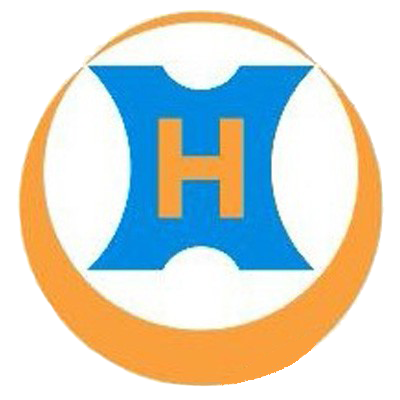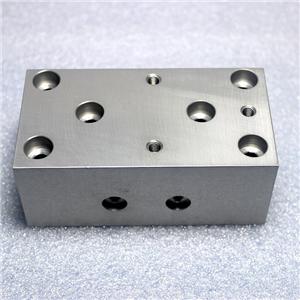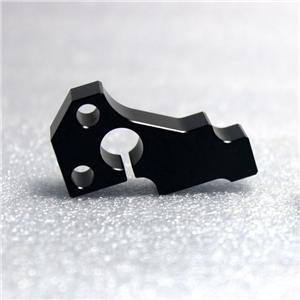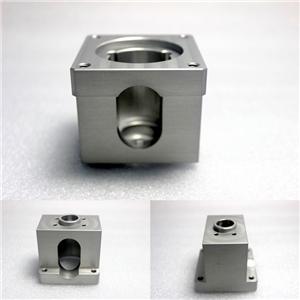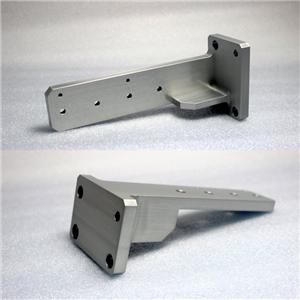-
1.Common problems and solutions of nc machining
CNC machine tools can be logically processed with a control code or other symbols of the instructions specified by the program to control the movement of machine tools, according to the shape and size requirements of the drawings, automatically make parts, so as to achieve a high degree of automation and compound centralized machine tools. The emergence of numerical control machine tools has solved the problem of complex, precise, small batch and multi-variety parts processing. But in the process of easy to appear tool wear, machining allowance is too large and so on. The following is a brief introduction of common problems and solutions of CNC machine tool processing:
1. processing flat, not only
In the CNC machine parts processing, finishing is an important process for the surface, but also often to do the process, the surface quality requirements are higher. But in the actual processing, sometimes will get uneven and not only plane, do not meet the requirements.
The main reason for this problem is that in the finishing process, the feed speed is too fast, and the vibration caused by the rapid movement of the tool is easy to leave uneven path to the machining surface. In addition, there is a problem in the opposite finishing, sometimes there will be a certain difference between the two adjacent tool path tool marks, is the direction of the cutting tool is not consistent, to avoid this problem, should use the full shun milling processing.
2. the finishing side of the knife mark is too obvious
In the workpiece processing of CNC machine tools, almost every workpiece will require fine milling side, and a lot of time will appear fine milling side of the knife mark is too obvious problem, this is absolutely not allowed to appear, will seriously affect the appearance of the workpiece.
The main cause of this problem is the improper selection of advance and retreat position and parameters, as well as the cutting in depth stratification. There are many kinds of machining software, and different machining software provides the milling method will also have differences, but will provide the depth selection of the under knife and in and out of the knife parameter selection. In order to avoid the above problems, we can make relevant adjustments in three aspects. The first is the selection of the feed point to be correct, should be selected in the most edge, not in the middle of the place, the point can no longer be the same side; The second is if must again in the middle of the knife, in advance and retreat of the knife, increase an overlap; The 3rd it is when undertaking flank finishing, had better use whole cut deep processing.
3. precision milling tool marks
In the ordinary processing and high-speed processing, need to carry out tool replacement, and if in the process of changing the knife operation do not pay attention to the parameters of the relevant adjustment, there will be obvious traces, serious impact on the appearance of the workpiece.
In the bottom or side of the fine milling, knife mark is a common phenomenon, many times people will think that this is unavoidable error, in fact, this is completely avoidable.In the processing of the workpiece, the precision machining of the concave corner needs to be replaced with a small tool, because the force in the processing process and swing, it will be in the corner is very easy to produce the trace of the knife.
4. after finishing surface or side to leave burr or batch front
Modern workpiece processing for the surface requirements are increasingly high, for the emergence of burr or batch edge is not acceptable, and if the file to correct the workpiece will affect the accuracy of the workpiece and size, etc. But in the actual production, there will still be a lot of burr and batch front.
And to solve this problem, the use of the tool must be very careful to use a special tool, to ensure sharp cutting. In addition, also want to do a good job in the planning of the knife road, increase the second finishing knife road, is the first processing surface, and then processing the side, and then processing the surface, so you can ensure that there is no burr and batch front, can not be polished workpiece is very useful.
5. for the special shape of the workpiece finishing
For some workpieces of special shape, the software usually has fitting error, sometimes if the error of calculation is too large, it will cause the deformation of the workpiece, affecting the appearance. To solve this problem, it is necessary to start from the software, the error of a reasonable control, neither affect the speed of calculation, nor cause deformation of the workpiece.
6. Serious tool wear causes errors
Tool precision directly affects the quality of the workpiece, and in the process of machining tool wear too fast will cause the deviation of the workpiece size. The causes of rapid tool wear include its own material, workpiece material, cutting process parameters, cutting oil properties and so on. -
2.Common problems and solutions in deep hole machining
1. Aperture reduction
Reason: the design value of reamer outside diameter is small; Cutting speed is too low; Excessive supply; The main Angle of reamer is too small; Improper selection of cutting fluid; The worn part of the reamer is not worn off when grinding, and the elastic recovery reduces the aperture. When reaming steel parts, the allowance is too large or the reamer is not sharp, easy to produce elastic recovery, so that the hole diameter is reduced and the inner hole is not round, the hole diameter is not qualified.
Solution: change the outside diameter of the reamer; Increase the cutting speed appropriately; Appropriate reduction of feed; Increase the main declination Angle appropriately; Choose oil cutting fluid with good lubricating property; Regular exchange of reamer, correct grinding reamer cutting parts; When designing the size of the reamer, the above factors should be considered, or the value should be determined according to the actual situation. For experimental cutting, take the appropriate allowance and sharpen the reamer.
2. Pore diameter increases
Causes: the reamer diameter is too large or the cutting edge of the reamer has burrs;Excessive cutting speed; Improper feeding or excessive processing allowance; Excessive main Angle of reamer bending; The cutting edge of the hinge adheres to the chip tumor;When grinding, the cutting edge of the hinge is out of tolerance. Improper selection of cutting fluid; When reamer is installed, the surface of taper handle is not cleaned or the taper surface is bruised; The flat tail offset of the taper shank is loaded into the conical interference of the taper shank behind the spindle of the machine tool; Spindle bending or spindle bearing too loose or damaged; Reamer float is not flexible; When not coaxial with the workpiece and hand reaming, both hands force is not uniform, so that the reamer shaking from side to side.
Solution: reduce the outer diameter of the reamer appropriately according to the specific situation; Reduce cutting speed adjust feed or reduce machining allowance; Properly reduce the main deflection Angle straightening or scrap bending reamer which can not be used; Carefully trim with whetstone to qualified; The control swing is within the allowable range;Select cutting fluid with better cooling performance; Before installing the reamer, the oil inside the taper shank of the reamer and the taper hole of the machine tool spindle must be wiped clean, and the taper surface with bumps must be polished with oil stone; Reamer flat tail adjustment or replacement of spindle bearing; Readjust floating chuck head and adjust coaxiality; Pay attention to correct operation.
3. The inner hole hinged out is not round
Causes: excessive length of reamer, insufficient rigidity, vibration during reaming; The main Angle of reamer is too small; Narrow cutting edge band;Reaming allowance deviation; The inner hole surface has gaps and cross holes; There are sand holes and air holes on the surface of holes. The spindle bearing is loose without guide sleeve, or the clearance between the reamer and guide sleeve is too large, and the workpiece is deformed after being removed due to too tight clamping of the thin-wall workpiece.
Solution: the lack of rigidity of the reamer can be used not equal pitch reamer, reamer installation should use rigid connection, increase the main deflection Angle; Select the qualified reamer, control the hole position tolerance of the preprocessing procedure;Adopt unequal pitch reamer, adopt longer and more precise guide sleeve; Select qualified blank; When using equal pitch reamer to ream more precise hole, the clearance of machine tool spindle should be adjusted, the fit clearance of guide sleeve should be higher or proper clamping method should be adopted to reduce the clamping force.
4. The accuracy of reamed holes is out of tolerance
Cause: guide sleeve wear; The bottom end of the guide sleeve is too far away from the workpiece; Short length of guide sleeve, poor accuracy and loose spindle bearing.
Solution: replace the guide sleeve regularly; Lengthening guide sleeve can improve the precision of fit between guide sleeve and reamer clearance. Timely maintenance of machine tools, adjust the spindle bearing clearance.
5. High surface roughness value of inner hole
Causes: cutting speed is too high; Improper selection of cutting fluid; The main Angle of the reamer is too large, and the cutting edge of the reamer is not on the same circumference. Excessive reaming allowance; Uneven or too small reaming allowance, local surface not reamed; The reamer cutting part is out of swing, the edge is not sharp, the surface is rough; Excessive width of cutting edge belt; Poor chip removal during reaming; Excessive wear of reamer; The reamer is bruised, and the cutting edge is left with burr or chipping edge; There are chip nodules on the edge; Due to material, it is not suitable for zero Angle or negative Angle reamer.
Solution: reduce the cutting speed; Select cutting fluid according to deep hole machining material; Properly reduce the main Angle, correct cutting edge grinding hinge;Reduce reaming allowance appropriately; Improve the position accuracy and quality of the bottom hole before reaming or increase the reaming allowance; Select qualified reamer;The width of the grinding blade belt; Reduce the number of teeth of the reamer according to the specific situation, increase the space of the chip holding groove or use the reamer with the edge Angle, so that the chip removal is smooth; Change the reamer regularly and grind the grinding area when grinding the edge; In the process of grinding, using and transporting the reamer, protective measures should be taken to avoid collision. For banged reamers, repair or replace the banged reamers with extra fine whetstone; With oil stone renovation to qualified, USES the anterior horn 5 ° to 10 ° of the reamer.
6. The inner surface of the hole has obvious edges
Causes: excessive reaming allowance; The rear Angle of the reamer cutting part is too large;Excessive width of cutting edge belt; The workpiece surface has blowhole, sand hole and the spindle pendulum is too big.
Solution: reduce reaming allowance; Reduce the back Angle of cutting part; The width of the grinding blade belt; Select qualified blank; Adjust the machine spindle.
7. The center line of the hole is not straight after reaming
Causes: the deviation of the borehole before reaming, especially when the hole diameter is small, cannot correct the original bending degree due to the poor rigidity of the reamer; The reamer main deflection Angle is too large; Poor guide makes the reamer easy to deviate from the direction in reaming;Cutting part inverted cone is too large; Displacement of the reamer at the clearance of the intermittent hole; When reaming by hand, excessive force in one direction forces the reamer to deflect towards one end, damaging the verticality of reaming.
Solution: add reaming or boring process correction hole; Decrease the main declination Angle; Adjust the appropriate reamer; Replace reamer with guide part or lengthened cutting part; Pay attention to correct operation.
8. Low service life of reamer
Causes: improper reamer materials; Burn the reamer while sharpening the blade; The cutting fluid selection is not suitable, the cutting fluid is not able to flow smoothly, the cutting place and the hinge cutting edge grinds the surface roughness value is too high.
Solution: according to the choice of reamer materials reamer materials, can use carbide reamer or coated reamer; Strictly control cutting parameters to avoid burn; Often choose cutting fluid correctly according to machining material; Often clear chip groove chip, with enough pressure cutting fluid, through fine grinding or grinding to meet the requirements.
9, reamer blade tooth collapse
Causes: excessive reaming allowance; The workpiece material hardness is too high; Excessive cutting edge swing leads to uneven cutting load. The main Angle of reamer is too small, which increases the cutting width. When reaming deep holes or blind holes, there are too many chips, which are not cleared in time, and the cutter teeth have been worn and cracked when grinding.
Solution: modify the hole size of pre-machining; Reduce the hardness of the material or change to negative front Angle reamer or carbide reamer; The control swing is within the qualified range; Increase the main declination Angle; Pay attention to remove the chip or use the Angle reamer with edge; Pay attention to the cutting edge grinding quality.
10. The handle of reaming tool is broken
Causes: excessive reaming allowance; When reaming taper holes, coarse and fine reaming allowance allocation and cutting parameters selection are not appropriate; Reamer tooth chip space is small, chip plug.
Solution: modify the hole size of pre-machining; Modify allowance allocation, reasonable choice of cutting parameters; Reduce the number of teeth in the reamer, increase the chip space or grind the clearance of the cutter teeth. -
3.CNC machining ten points
1, processing order should be arranged according to what principle?
The arrangement of processing order should be based on the structure of parts and blank condition, as well as the need to consider the positioning clamping, the key is that the rigidity of the workpiece is not destroyed.Order generally should be carried out according to the following principles: (1) the process of the last process cannot affect the next process of positioning and clamping, interlaced with general machine tool processing process also want to consider. (2) advanced line shape cavity processing sequence, after the shape processing process. (3) with the same positioning, clamping way or the same knife processing process is best connected. (4) in the same installation of multiple processes, should first arrange the workpiece rigid damage small process.
2. Process division method?
(1) tool centralized sorting method: according to the tool division process, with the same tool processing parts on all parts can be completed.Use the second knife and the third knife to do what they can do. (2) to process the parts of the order method: for the processing of a lot of parts, according to its structural characteristics of the processing part is divided into several parts, such as shape, shape, surface or plane. (3) to rough, fine processing sub-order method: for easy to produce processing deformation parts, due to rough processing may occur after the deformation and need to be calibrated, so generally speaking, where to carry out rough, fine processing will be separated from the process.
3. the workpiece clamping way determination should pay attention to which several aspects?
In determining the positioning of the benchmark and clamping scheme should pay attention to the following points: (2) try to reduce the number of clamping, as far as possible in a positioning can be processed after all the surface to be processed. (3) to avoid the use of machine manual adjustment program. (4) fixture to open, its positioning, clamping mechanism can not affect the processing of the knife (such as collision), in such cases, can be used with vise or add the bottom of the way to remove the screw clamping.
4. how to determine the reasonable knife point?
The knife point can be processed in parts, but pay attention to the knife point must be the benchmark or already processed parts, the first step in the attention to the knife to have relatively fixed size relations with the locating datum places set up a location relative to the knife, so that we can according to the relative position between them relations back to the original cutting point.This position is usually located on a machine tool table or fixture.The selection principle is as follows: (1) find is easy. (2) convenient programming. The knife error is small. (3) when the processing inspection is convenient.
5. how to choose a reasonable processing tool?
When face milling, the end milling cutter or end milling cutter should be selected. The end milling cutters of the end milling cutters and insert carbide blades are mainly used for machining the convex head, groove and box mouth surface.Ball knives and round knives ( also known as round nose knives) are often used for machining curved surfaces and bevel contour shapes. And the ball knife is used for semi - finishing and finishing. Circular cutters with carbide inserts are usually used for roughing.
6. What is the function of the processing procedure sheet?
Processing program is one of the contents of numerical control machining process design, but also need the operator to comply with, the implementation of the procedures, is the specific description of the processing process, the purpose is to let the operator clear program content, clamping and positioning method, the selection of the tool processing process should pay attention to the problem.
7. What is the relationship between the workpiece coordinate system and the programming coordinate system?
The origin position of the workpiece coordinate system is set by the operator himself, it is determined after the workpiece clamping, through the knife, it reflects the distance between the workpiece and the zero position of the machine tool. Once the workpiece coordinate system is fixed, it is generally not changed. Both workpiece coordinate system and programming coordinate system must be unified, that is, workpiece coordinate system and programming coordinate system are consistent during processing.
8. What factors should be considered in determining the cutting route?
Guarantee the processing accuracy of parts. (1) convenient numerical calculation, reduce the programming workload. (2) to seek the shortest processing route, reduce the empty knife time to improve the processing efficiency. (3) try to reduce the number of procedures. (4) to ensure the roughness of the workpiece contour surface processing requirements, the final contour should be arranged for the last piece of continuous processing out.6. The advance and retreat of the knife (cut and cut) line should also be carefully considered, in order to minimize the outline of the knife and leave a knife mark.
9. the cutting tool cutting parameters have several major factors?
Cutting parameters have three elements: cutting depth, spindle speed and feed speed.The general principle of cutting parameters selection is: less cutting, fast feed (that is, small cutting depth, fast feed speed).
10.What is DNC communication?
Program delivery methods can be divided into CNC and DNC two, CNC refers to the program through the media (such as floppy disk, tape reader, communication lines, etc.) to the storage of the machine tool storage storage, processing from the storage program to process. Because the memory capacity is limited by the size, so when the program is large, DNC processing can be used, because the DNC processing machine tool directly from the control computer to read the program (that is, while doing), so not by the memory capacity is limited by the size. -
4.How to straighten out each link of product development, reduce mistakes and enhance the added value of products?
1. The drawing design to achieve precision, fine, accurate
Some of our drawings are provided by customers, and some are designed by ourselves. After the design is completed, we need to print a set of drawings completely and check them carefully. It is better to use 3d design software to assemble them completely and check the size of each part.
2. The preparation of the schedule shall be completely consistent with the actual situation
Detailed list preparation is a meticulous work, each part should be carefully checked, and to the site and the template, drawings, there can be no mistake, leakage, more than the case.
3. Mold acceptance shall not be sloppy
Mold acceptance is a professional work, product developers, mold designers, mold makers should be involved, mold materials, parts of the size, mold structure rationality, life is a very important index.
4. The product tries to install, the sample manufacture must be able to discover the question
The purpose of product fitting is to find problems, record them and solve them one by one.
5. The product hangs the code to want to check carefully
The product code is the most prone to error, and there are many lessons to be learned. The name, quantity, material and technical requirements of parts are very important data. If a certain data is wrong, it will cause great economic losses to enterprises, especially for the borrowed parts. Product code hangers, developers and technicians must carefully check.
6. Small batch trial production should be considered comprehensively
Small batch trial production is a link between the preceding and the following, all aspects should be considered, after the completion of trial production to do a good job of product experiments, and do a good job of product review.
7. Make sure everything is safe for mass production
